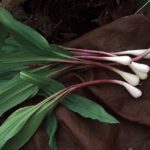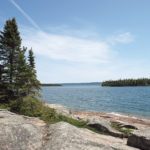Spring in the North is an acquired taste. In some ways it’s like coffee—a little muddy and bitter, but after a while it’s hard to imagine life without it.
May in particular is a beautiful, unique time to be on the North Shore. Hiking trails are less crowded, bugs are still dormant, and the birdwatching is at its best just before the leaves bloom. The star of this spring-time show, however, are the waterfalls.
There are so many waterfalls along the North Shore of Lake Superior—more than most people will see in a lifetime of exploring—and the best time to experience these watery wonders is during the spring melt when water levels are at their highest. They range in size from the fleeting “phantom falls” that decorate rockfaces along Superior and Highway 61 after a heavy rain, to the 131-foot Niagara-like cascade that is Kakabeka Falls near Thunder Bay.
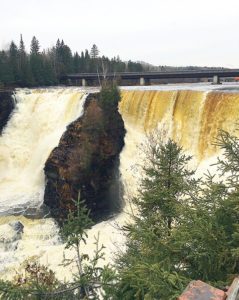
Spring waterfalls are beautiful, but they can also be treacherous. It is important to bring appropriate gear for the day’s conditions—extra layers, food and water, as well as hiking boots with good traction (maybe even a pair of snow cleats depending on the spring), hiking poles, and a first aid kit. Make smart choices and don’t forget a camera.
Kakabeka Falls
At a whopping 131 feet high, Kakabeka Falls is the second highest waterfall in Ontario. Accessing the falls is an easy walk from the parking lot, but there are a few more challenging hikes (especially during spring conditions) that give access to portions of the Kaministiquia River as well as Little Falls, which—despite its name—is well worth the extra effort.
Nicknamed “Niagara of the North,” Kakabeka Falls has been carving itself out of the unstable shale beneath its flows since the decline of the last ice age. The surrounding layers of shale contain some of the oldest fossils in existence—some as old as 1.6 billion years—and the waters beneath the falls are a preferred spawning area for endangered Lake Sturgeon.
The Legend of Green Mantle: Look closely into the mist off the Kaministiquia River as it roars over Kakabeka Falls and you might just see Princess Green Mantle; the Ojibwe princess who selflessly led a troupe of Sioux warriors over the edge of the falls to save her tribe from attack. Read more about the legend at: bit.ly/kakabekafallslegends.
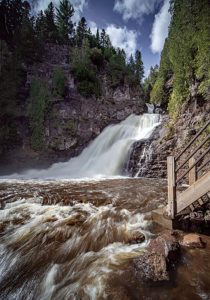
Caribou Falls
The Caribou Falls State Wayside is often overlooked but well worth a visit. The trailhead and parking lot are well maintained, as is the 1.2-mile out-and-back trail to the falls. At 35 feet in height, Caribou Falls is an impressive sight to see, and in the summer when water levels are lower and the current is less severe, it can be a fun place to go for a swim.
Pro tip—after taking the stairs down to Caribou Falls, hike back up and continue along the trail towards the top. There is a platform that overlooks the falls from above, and the short hike to get to it passes beneath a number of gorgeous white pine. Well worth the extra effort.
Devil’s Kettle
Perhaps the most famous of the North Shore waterfalls because of its “mysterious Kettle,” Devil’s Kettle is a must see for anyone willing to hike out to it.
The kettle itself is only 1.5 miles from the mouth of the Brule River, but the 200-plus stairs that lead down to the series of waterfalls that contain the Devil’s Kettle are way less fun on the way back up. The closest trailhead to Devil’s Kettle is located in Judge C.R. Magney State Park, so be prepared to pay a small parking fee that goes towards the maintenance and protection of the park.

For years, nobody knew where all of the water that pours into the Devil’s Kettle disappeared to. There are rumors of people trying to solve the mystery using colored dyes, GPS equipment, and even ping pong balls, but nobody was able to figure it out…that is, until recently when hydrologists working for the DNR used “science” to solve the age-old mystery. But why give it away here? Some mysteries are better left unsolved.
High Falls on the Pigeon River
High Falls is the tallest waterfall in Minnesota with a top to bottom height of 120 feet. Located in Grand Portage State Park right on the U.S. Canadian border (i.e., the Pigeon River), High Falls is an accessible 0.5-mile out-and-back hike along a paved trail. On most days in the spring, mist rises up from below high enough to soak the various overlooks—so don’t forget to bring a rain jacket.
Parking is available right off of Highway 61 before the border crossing, and there is a great visitor center at the trailhead with information about the falls and surrounding area. Looking out over the raging river from the trail, it’s wild to imagine what it would have been like for the voyageurs portaging their canoes around the rapids below. Would they have been impressed or frustrated by the impassable falls? Probably a little bit of both.
Johnson Falls
Of all of the waterfalls in Northeastern Minnesota, Johnson Falls is perhaps the most challenging to access. Johnson Falls is a two-tiered waterfall that is remote even by Boundary Waters standards, and requires a bit of bushwhacking off of Pine Lake to even find.
There are a number of ways to get to Johnson Falls, all of which involve a mix of paddling and portaging.
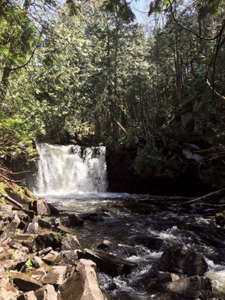
The two most common put-ins are either at Clearwater Lake or East Bearskin, with the Clearwater route requiring more portaging but less paddling, and the East Bearskin route more paddling but less portaging. Most folks paddling to the falls use it as an excuse to spend a night or two (or five) camping in the BWCAW, but out and back to the falls can be done in a full day of paddling.
To get a better sense for what it takes to access the falls, its best to contact a local outfitter. Not only will they provide up-to-date trail conditions and equipment, but they will help set expectations for aspiring adventurers. An important element of being prepared is knowing what to expect on a trip, especially when traveling into remote areas like the BWCAW.
For further information on accessing Johnson Falls, check out the description on Clearwater Outfitter’s website at: clearwateroutfitters.com/trail-johnson-falls.
Make it an Adventure!
With so many options, the best advice is to get creative in experiencing spring waterfalls. See how many you can see in a day! A two-hour drive is all that separates Caribou Falls near Silver Bay from Kakabeka up in Ontario, and there are so many easy access falls in between—Cross River, Temperance, Onion River, Cascade, Fall Creek, Kadunce, Devil’s Kettle and High Falls to just name a few…




